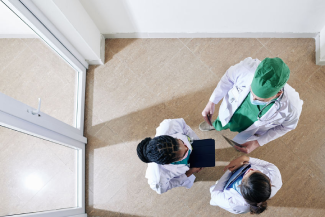Moisture-Associated Skin Damage: Your Questions Answered
May 17, 2017
On April 26, 2017, I presented a webinar on the topic of Moisture-Associated Skin Damage (MASD) as part of WoundSource's webinar series on skin and wound related topics. MASD is a general term that encompasses a variety of skin injuries which involve excessive hydration of the skin. A strong knowledge of MASD can help clinicians in the assessment, prevention and treatment of the various types of moisture related skin injuries. During the informative presentation, I discussed such topics as:
- How to identify the different types of MASD
- What other types skin damage may occur with or lead to MASD
- Common risk factors for skin injury
- Comprehensive assessment of MASD
- Prevention and treatment strategies
Frequently Asked Questions about Moisture-Associated Skin Damage
Afterward the presentation, there was a Q&A session with the participants of the webinar. This is a selection of some of those questions and their answers:
Q) How do you differentiate MASD from other conditions such as pressure injury?
A) If the injury is blanchable, it is a MASD, and if it is non-blanchable, the condition is a pressure injury.
Q) Are there any conditions that may present as MASD in assessment that clinicians the should be aware of?
A) Both pressure injuries, and medical adhesive-related skin injuries can be mistaken for MASD.
Q)What are some strategies for preventing MASD in relation to excessive wound exudate?
A) Moisture absorbent wound dressings and negative pressure therapy are both good strategies, if the patient meets the selection criteria.
In regard to protecting the periwound skin, pH-balanced no-rinse skin cleanser, skin sealant moisture barrier ointments and creams, as well as zinc-based creams are also good strategies.
Q) What are some ways we can manage pain associated with MASD for our patients?
A) Once topical treatment is started, immediate pain relief usually occurs.
Q) What skin sealants are recommended for patients with MASD?
A) Non-alcohol based. They are available in a variety of delivery methods including wipes, sprays, and applicators. It is important to allow the sealants to dry thoroughly to avoid opposing skin surfaces from sticking together.
Q) When a fungal infection is present, which is most helpful: an antifungal cream, or a powder?
A) It depends on the location of the fungal infection. At times an antifungal powder works best when you are trying to decrease the accumulation of moisture in a skin-fold, especially under the breasts or abdominal folds. In those cases, liberal dusting of the affected area area followed by the application of a skin sealant, which should be allowed to dry thoroughly. Use of a therapeutic moisture absorbing skin shield can enhance the treatment.
Q) Once a person has a fungal infection, are they more prone to having a recurrence?
A) If the underlying case is not well-managed, then yes, they are.
Q) What barrier adheres best to weeping skin tissue?
A) Skin sealants are designed to adhere to weeping skin. If you are looking for a barrier cream or ointment, one containing a hydrocolloid power in the ingredients is helpful. Barrier creams and ointments containing zinc, which also adheres well to moist skin and they contain some antibacterial/antifungal properties. It is always important to apply the antifungal treatment first before applying anything else. There are barrier ointments that already contain an antifungal ingredient.
Q) How do you determine is the MASD is intertriginous dermatitis (ITD) or incontinence associated dermatitis (IAD) related?
A) This can be tricky, but a good patient history and physical assessment are essential. The appearance of both conditions can be similar, but odor can be a differentiating factor.
I hope the webinar, and the question and answer session that followed helped shed some light on the various treatment options related to moisture associated skin damage. To view the WoundSource webinar session on demand, click here.
About The Author
Paula Erwin-Toth has over 30 years of experience in wound, ostomy and continence care. She is a well-known author, lecturer and patient advocate who is dedicated to improving the care of people with wounds, ostomies and incontinence in the US and abroad.
The views and opinions expressed in this content are solely those of the contributor, and do not represent the views of WoundSource, HMP Global, its affiliates, or subsidiary companies.










